What is Parts of Speech in English Grammar: In this article, we are going back to basics. We are looking at the building blocks of spoken English. You will be reading about “What is parts of speech in English grammar” and “The eight parts of speech.” Every single word you say has a role within a sentence. Every single word is a part of speech.
Today, we’re going to be breaking it down and looking at each one. It makes up nearly everything that we say in English. So, we might as well get it right from the very beginning.
What is Parts of Speech in English Grammar

There are a total 8 parts of speech in Egnlish grammar. For example:
- Nouns
- Pronouns
- Adjectives
- Verbs
- Adverbs
- Prepositions
- Conjunctions
- Articles
1. Nouns
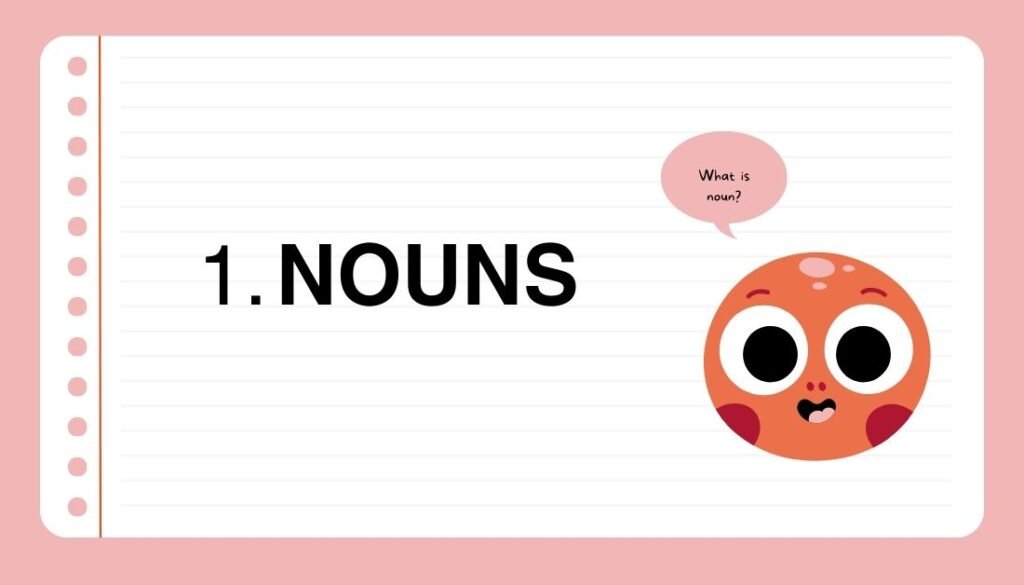
A noun is something that names something, such as a person, an idea, or a thing. In a sentence, a noun can play the role of a subject, an indirect object, a direct object, a subject complement, an object complement, and a positive or an adjective.
Types of nouns: There are so many different types of nouns.
- People: They can name people such as a girl, Taylor Swift, my dad, etc.
- Place: They can name a place, a mountain, Spain, the kitchen. etc.
- Things: They can also name things, activities, concepts, processes, ideas, such as love, rugby, shorts, knowledge, etc.
2. Pronouns
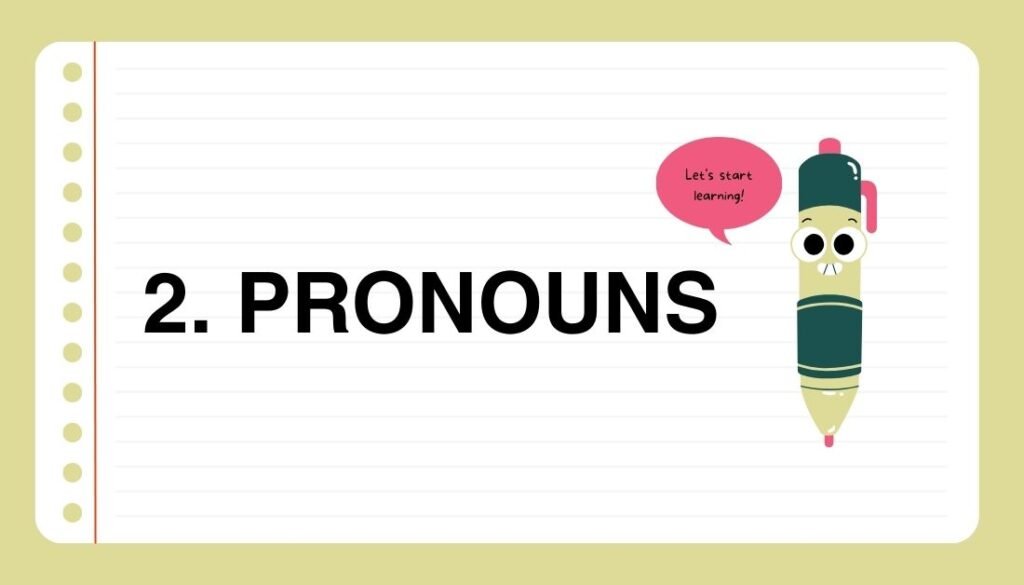
Let’s move on to the second part of speech: pronouns. A pronoun is a word that’s used instead of a noun or a noun phrase. You use them when the reader or listener already knows the specific noun that you’re referring to.
If I tell a story, for example, about my fiancée, John, it will get so boring and repetitive if I just say the noun William over and over again. Let’s try, let’s see how it sounds.
- John is my fiancé.
- John is extremely tall.
- John told me that John wants to marry me.
You see, It makes me sound obsessed and weird, to be honest, and very repetitive.
Let’s try it with a lovely pronoun instead.
- John is my fiancé.
- He’s very tall.
- He told me he wants to marry me.
It sounds a little better, less obsessive, less boring.
Types of Pronouns: there are quite a few different types of pronouns, and some pronouns are found in more than one category. I will present you with some of the most common.
1. Personal pronouns
We use personal pronouns as a simple substitute for the proper name of a person. The personal pronoun is a short word that is associated primarily with a particular grammatical person. [what is parts of speech in english grammar] We have the personal pronouns:
- I
- me
- you
- she
- her
- he
- him
- we
- us
- they
- them
2. Demonstrative pronouns:
We also have demonstrative pronouns and these pronouns are used to represent something you don’t have to repeat words. In simple words, demonstrative pronouns are used to point to something or someone specific.
- this
- these
- that
- those
For example, this is my brother, that is a table.
3. Indefinite Pronouns:
We also have indefinite pronouns, and these are used when the personal thing doesn’t need to be specifically identified. For example:
- one
- other
- everybody
- anybody
- nobody
For example: everybody loves my homemade brownies, or some love Marmite, others hate it.
4. Interrogative pronouns:
Other types include interrogative pronouns. these pronouns are used to ask questions. For example:
- what
- who
- what
- which
- whom
- whose
5. Progressive pronouns:
These pronouns are used to point to the ownership (possession) of something or someone by something or someone else.
- my, mine
- your
- their
- whose
- his
- hers
- theirs
6. Reflexive and intensive pronouns
Reflexive pronouns refer back to a person or thing. These pronouns are used when the subject and the object of a verb are the same while intensive pronouns add emphasis or intensity to a noun. Intensive pronoun word always end in -seld or -selves which is used in combination with a noun or pronoun to place special emphasis on it. [what is parts of speech in english grammar] For example: John hurt himself, Maria cut herself when she was preparing dinner last night. Reflexive and intensive pronouns are:
- myself
- yourself
- themselves
- ourselves
- herself
- himself
- itself
7. Relative pronouns:
These types of pronouns are used to introduce a relative clause. Thse pronouns join different clauses together by referring to the noun in the previous clause using the pronouns.
- whom
- that
- who
- what
- which
For example: the musician who wrote this song, this is the house where my son was born.
3. Adjectives

Let’s move on to part of speech number three: adjectives. These might be my favorite actually. These are the words that describe nouns, and an adjective can go right before the noun it’s describing.
I feel like this is a sneaky secret. It’s so secret that many native speakers don’t even know they’re using it. But when you present them with this information, they are blown away because everyone follows the same order without even thinking about it.
Students Also Read: English Spelling Rules With Examples
Now, one of the most important things that you can learn when it comes to adjectives is adjective order.
- Opinion: ugly, beautiful, delicious, fascinating
- Size: big, tall, tiny, small, large
- Physical quality: neat, rough
- Shape: round or square.
- Age: old, new, young, ancient
- Color: pink, orange, blue. pink
- Origin: Egyptian, Japanese, American, French
- Material: plastic, leather, glass, metal
- Purpose: cooking, gardening,
- Sound/texture: loud, soft, rough
- Condition: clean, broken, worn
For example: He is a fast driver, What a delicious taste fo this apple. My dog has blue eyes.
4. Verbs
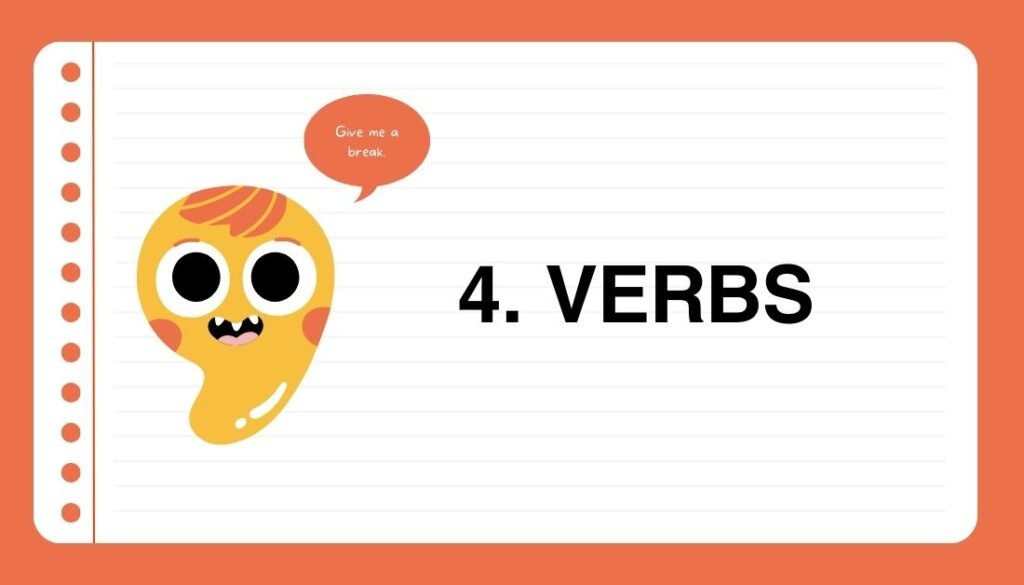
The part of speech number four: verbs. A verb is a word that shows a physical action (cook), mental action (think), or a state of being (exist). Verbs are used almost in every sentence and verbs show what noun or pronoun is doing. For example:
- Listen to me.
- Write what you hear!
- Learn to speak.
Everything that is in bold here is a verb, we use them all the time. Verbs are words that describe actions.
Types of verbs: there are many types of verbs, for example: Dynamic or action verbs, Stative verbs, Auxiliary verbs, modal auxiliary verbs, and phrasal verbs. Each type of verb serves a different purpose in a sentence. [what is parts of speech in english grammar]
1. Dynamic or action verbs:
We have dynamic or action verbs that describe literal actions. Dynamic can be identified easily because they occur externally. These verbs tend to be motivated actions with a beginning and end. So these verbs can be defined as motivated actions.
For example: run, eat, talk, jump, sing, cook
2. Stative verbs:
We also have stative verbs that refer to feelings in states. Stative verbs express a state rather than an action. Unlike dynamic verbs, stative verbs tend to be subjective and have no definitive start or end. For example: to like, to love, to think, to feel, etc.
- I like you
- It appeared to be cloudy
- I believe in God
- This shoe fits me
3. Auxiliary verbs:
Auxiliary verbs are used in English to change another verb’s mood, voice, or tense. This is why they’re referred to as helping verbs. They are minor verbs that support the sentence’s main verbs. The main auxiliary verbs are: be, is have, do, am, was, were, been, had, be able to, etc. For example:
- John is coming to my party
- We were studying
- My family has traveled to Athens before
4. Modal auxiliary verbs
We also have modal auxiliary verbs, commonly called modals or modal verbs. These are a big pain point for many students learning English because they’re so annoying, they are annoying. Modals are added to another verb to show capability, or possibility, or necessity as well.
Common examples are may, might, must, can, could, should, shall, and would, will, and ought to.
5. Phrasal verbs:
Everyone seems to find phrasal verbs so annoying, and they’re really, really frustrating, but I really enjoy teaching them. These are phrases that act as a single verb, they usually consist of a verb and a preposition. For example:
- check off
- Let on
- get around
- break into
- bring back
- back out
5. Adverbs

Let’s talk about adverbs. An adverb is a word that describes an adjective, a verb, another adverb, or even a sentence. Have a look at these examples:
- I gently lifted him out of bed. (Here the adverb is describing a verb)
- He is more interesting than you
- That is an unusually tall tree. (here the adverb is describing the adjective.)
- Unfortunately, we had already left. (Unfortunately, the adverb is describing the whole sentence.)
6. Prepositions
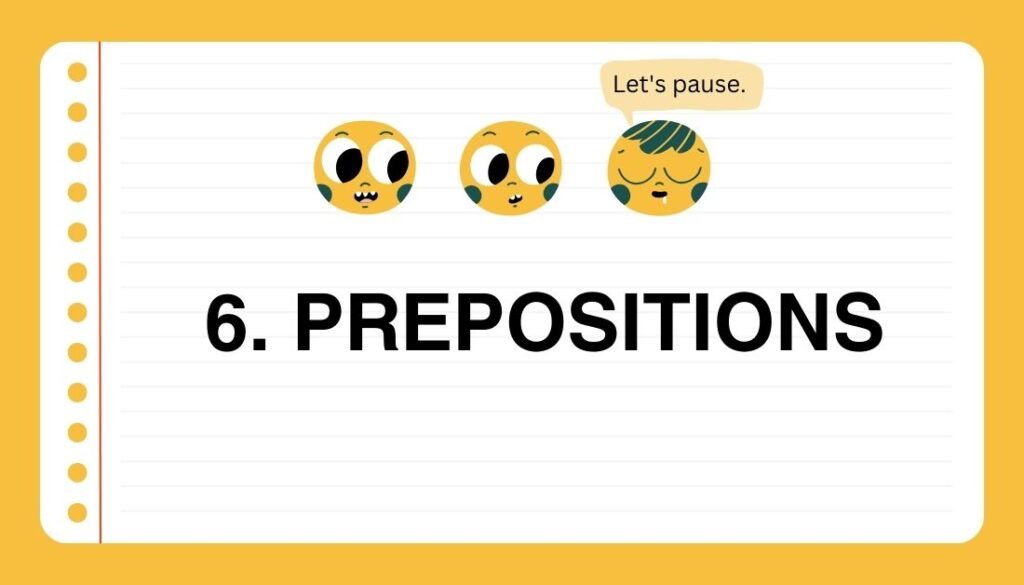
Let’s move on to prepositions. Another topic that learners of English tend to find quite tricky. A preposition is a word that tells you when or where something is in relation to something else. It tells you the relationship between words in a sentence. [what is parts of speech in english grammar]
- I put my bag on the table.
- I sat beside the wall.
- My birthday is on Monday.
Common Myth for Using Prepositions
Now let’s take this opportunity to bust a preposition myth. I hate this myth so much, it annoys me all the time. I have lots of students telling me off because they’ve been mistaught about this myth by their teachers. Some people are adamant that you should never end a sentence with a preposition, and they are wrong. And teachers say this and it bugs me.
1. Read these example sentences and see which one sounds more natural.
- Where do you come from?
- From where do you come?
Where do you come from, being a preposition at the end of a sentence sounds absolutely fine.
2. Second example:
- That’s where you went to!
- That is to where you went!
3. Another example, are you going to the party? Now how would you answer ?:
- I don’t know who I’m going with.
- I don’t know with whom I’m going, You could say, but it’s just too formal.
So yes, there are many occasions when using a preposition to end a sentence is wrong, especially in formal writing or formal speech.
Don’t let pedants make you scared to speak.
7. Conjunctions
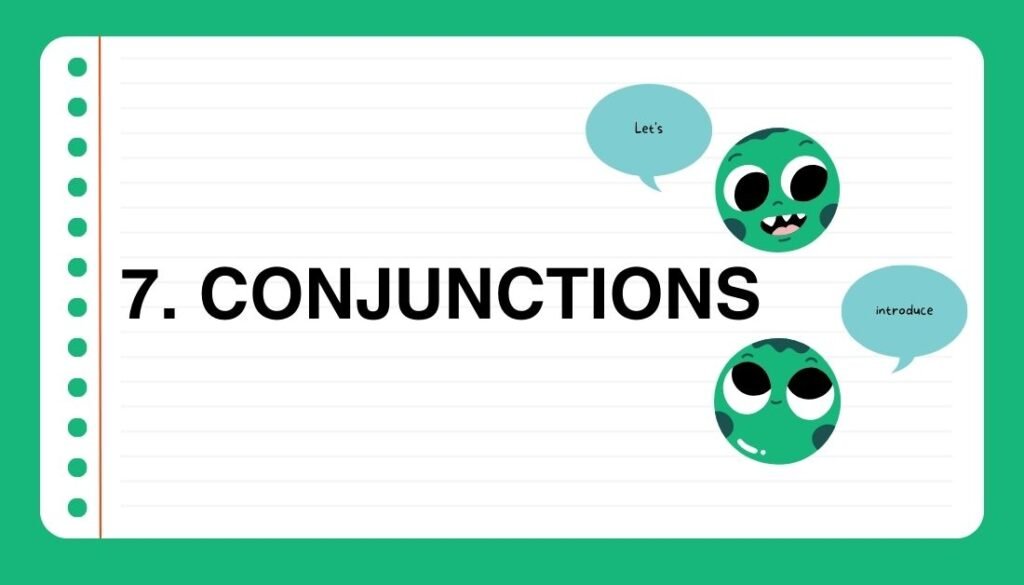
Part of speech number seven is conjunctions. A conjunction is a word that’s used to connect clauses, sentences, or words together.
1. Coordinating conjunctions
Firstly, let’s look at coordinating conjunctions. They allow us to join words, phrases, or clauses of equal rank.
No, literally, for, and, nor, but, or yet, so.
For example: Here we have two sentences or clauses of equal rank:
- I had a terrible headache.
- I still went to school.
We can join them together with a coordinating clause.
- I had a terrible headache, but I still went to school.
2. Correlative conjunctions
We also have correlative conjunctions. These are pairs that work together like either and or, or neither and nor.
For example: I want either the beef or the turkey roast.
3. Subordinating conjunctions
There are also subordinating conjunctions, which join dependent and independent clauses. Common subordinating conjunctions are: because, since, as, although, though, while, or whilst, and whereas.
For example: I ate dinner because I was hungry, I drove while talking on the phone. [what is parts of speech in english grammar]
8. Articles
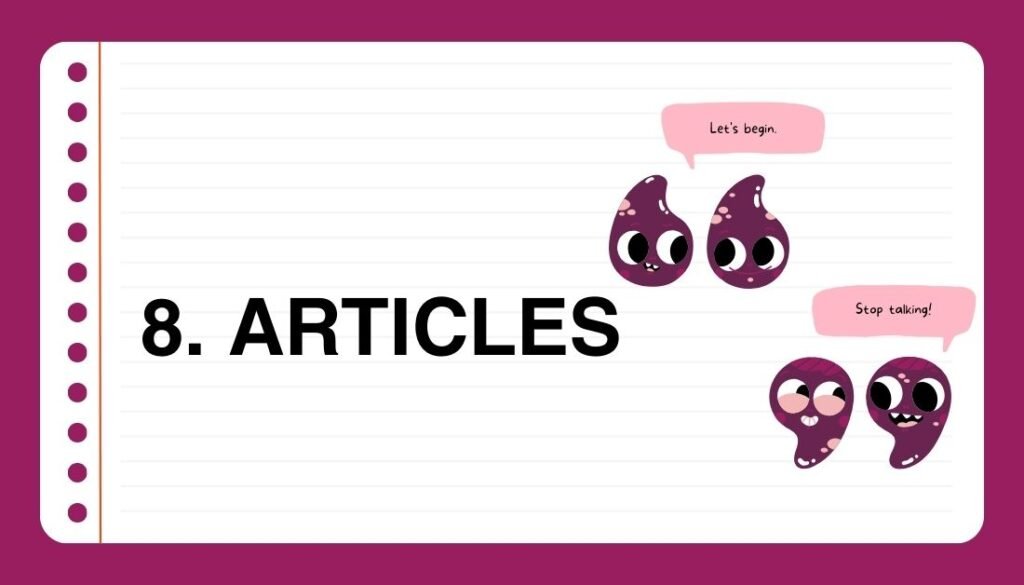
Finally, we have number eight, the eighth part of speech, the articles, a very important part of speech.
1. Definite article
The definite article is the word “the”. It limits the meaning of a noun to one particular thing. For example: Give me the ticket.
I am talking about a specific ticket that both of us know about, the ticket, not a ticket, not another ticket, the ticket.
2. Indefinite article
The indefinite article is “a or an”. It is “a” when it precedes a word that begins with a consonant or it is “an” when it precedes a word that begins with a vowel. The indefinite article indicates that a noun refers to a general thing, a general idea, rather than a specific thing.
- Can you pass me an apple? (note: I said a because it starts with a vowel sound.)
- Should I bring a bottle of wine tonight? (note: Not the bottle of wine) Should I bring the bottle of wine implies that it’s a very special bottle of wine that we both know about.
Conclusion
Right. That is it for my lesson on the eight parts of speech. Learning grammar could be complicated but it’s not hard to learn. [what is parts of speech in english grammar] All you need is consistency and dedication. In this article, you have learned so far what is parts of speech and their further categories like nouns, pronouns, adverbs, adjectives, verbs, prepositions, conjunctions, etc. I also gave detailed information about each type of category. I hope you enjoyed it, and I hope you learned something.
Students Also Read: Which Grammar is Important to Speak English: Basic Rules